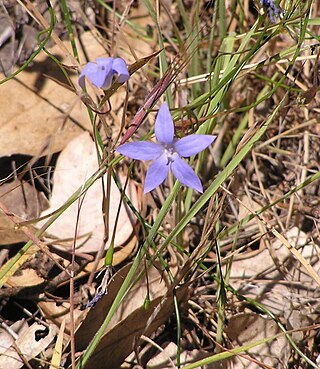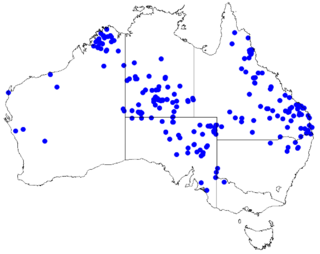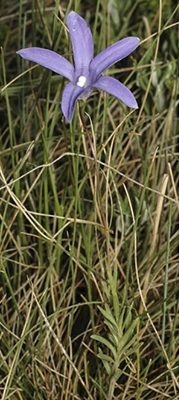
Wahlenbergia gloriosa, commonly known as royal bluebell is a perennial herb in the bluebell family Campanulaceae. It has egg-shaped leaves near the base of its stem, linear leaves higher up and usually a single purple flower with a tube-shaped base. The flower is the floral emblem of the Australian Capital Territory.

Wahlenbergia stricta, the Australian bluebell, tall bluebell or austral bluebell, is an Australian wildflower from the Campanulaceae family. It is considered the most commonly encountered of the Wahlenbergias. It is found in all Australian states but not the Northern Territory. It is often seen growing by the side of the road, enjoying the extra runoff.

Drosera graniticola is an erect perennial tuberous species in the carnivorous plant genus Drosera that is endemic to Western Australia. It grows 10–20 cm (4–8 in) high near granite outcrops. White flowers emerge from August to September.

Wahlenbergia gracilis, commonly known as Australian bluebell or sprawling bluebell is a perennial tufted herb from the family Campanulaceae. The species is widespread throughout eastern Australia, with a range from Cape York to southern Tasmania. The species is not considered at risk.

Wahlenbergia capillaris, commonly known as tufted bluebell, is a plant in the family Campanulaceae and is native to Australia and New Guinea. It is an erect perennial herb with a few to many stems and grows to a height of 50 cm (20 in). The leaves are mostly linear with a few scattered teeth on the sides and the flowers are blue, bell-shaped with five lobes and arranged in cymes. This bluebell is widespread and common, occurring in all Australian mainland states and territories.

Wahlenbergia queenslandica is a small herbaceous plant in the family Campanulaceae native to Western Australia, to New South Wales, Queensland, the Northern Territory, and South Australia.

Wahlenbergia ceracea, commonly known as the waxy bluebell, is a small herbaceous plant in the family Campanulaceae native to eastern Australia.
Wahlenbergia aridicola is a small herbaceous plant in the family Campanulaceae native to eastern Australia.

Wahlenbergia fluminalis, commonly known as the river bluebell, is a small herbaceous plant in the family Campanulaceae native to eastern Australia.

Wahlenbergia densifolia, commonly known as the fairy bluebell, is a small herbaceous plant in the family Campanulaceae native to eastern Australia.
Wahlenbergia glabra is a small herbaceous plant in the family Campanulaceae native to eastern Australia.

Wahlenbergia littoralis is a small herbaceous plant in the family Campanulaceae native to eastern Australia.

Wahlenbergia luteola is a small herbaceous plant in the family Campanulaceae native to eastern Australia.
Wahlenbergia planiflora, commonly known as flat bluebell, is a small herbaceous plant in the family Campanulaceae native to eastern Australia.

Wahlenbergia scopulicola is a herbaceous plant in the family Campanulaceae native to eastern Australia.
Wahlenbergia victoriensis is a herbaceous plant in the family Campanulaceae native to eastern Australia.

Wahlenbergia capensis, commonly known as the Cape bluebell, is a plant in the family Campanulaceae and is native to the Cape Province but has been introduced to Australia. It is an annual herb with up to four greenish blue, bell-shaped flowers with spreading petal lobes.

Roger Charles Carolin is a botanist, pteridologist and formerly an associate professor at Sydney University. He was appointed as a lecturer in botany at the University of Sydney in 1955 earned a Ph.D from Sydney University in 1962 with a thesis on the floral morphology of the campanales, and retired as an associate professor in 1989.
Pomaderris graniticola is a species of flowering plant in the family Rhamnaceae and is endemic to eastern Australia. It is a shrub or small tree with hairy young stems, lance-shaped to elliptic leaves, and sparse panicles of yellow, white or cream-coloured flowers.

Hovea graniticola is a species of flowering plant in the family Fabaceae and is endemic to eastern Australia. It is a shrub with its branchlets covered with curly brownish to grey hairs, narrowly oblong to almost linear leaves with stipules at the base, and mauve, pea-like flowers.














